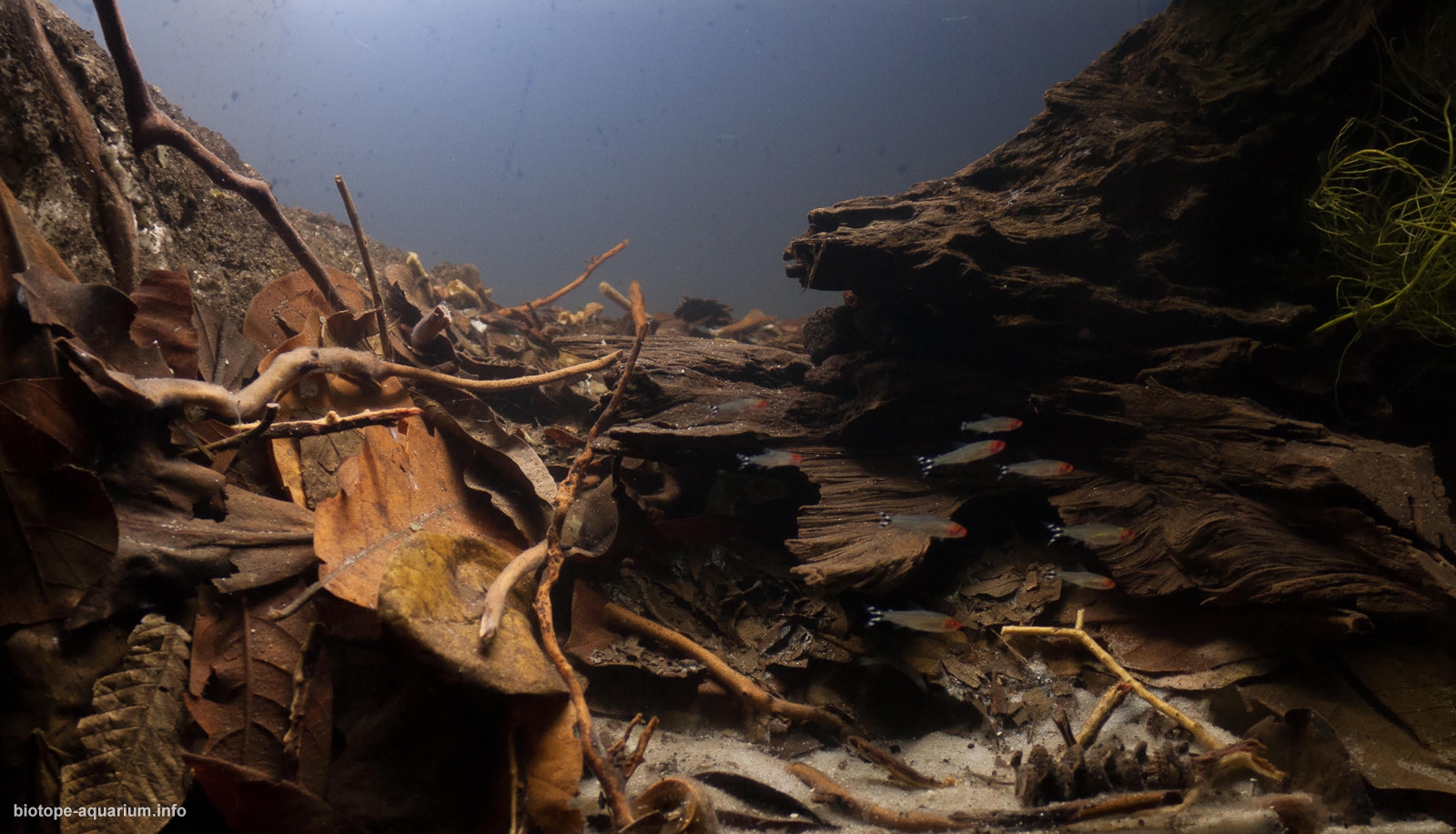Rummy-nose tetra habitat, floodplain drainage stream, middle Rio Orinoco, Colombia
53rd place in Biotope Aquarium Design Contest 2018
![]() USA. Rich Schram
USA. Rich Schram

Volume: 117 L
Dimensions: 65x40x45 cm
List of fishes: Hemigrammus rhodostomus
List of plants: N/A
Description of decorations: First, a structure of lava rock and driftwood was used to built and covered with foam to build up the slope and provide depth. Additionally, the lava rock, with some flow pushed into the structure, should provide porous areas for beneficial bacteria to develop. Next, the foam was covered with a mixture of crushed ADA Amazonia, pool sand, and crushed leaves. A layer of various leaves procured from Tannin Aquatics was then placed along the slope. Multiple small twigs from driftwood was interspersed amongst the leaves. A large driftwood structure was assembled to resemble the same feature in my inspiration video. A layer of sand was placed in front of this structure. Finally, a few seed pods (also from Tannin Aquatics) and twigs were placed into the sand.
Description of equipment: Aquavas Sun LED light system, with only one bank of lights in use. Finnex FugeRay Planted+ Cliplight; used to provide slight backlighting. Eheim 350 Surface Skimmer. Eheim Jager 100 Watt Aquarium Heater. Aquaclear 20 HOB filter.
Water parameters: Soft water, pH 6.5, 26 C.
INFORMATION ABOUT BIOTOPE
Description of the area surrounding the biotope: The middle Rio Orinoco passes through the Vichada Department in Colombia. There is little forest in this area, except for along the river itself. However, this only extends about 50 m out from the permanent water on each bank. This land consists mainly of large savannas, many of which become flooded during the rainy season. During the dry season, creeks in these areas drain the floodplain into the main river. They are very slow flows, and often less than 50 cm deep. The aquarium I have created is a representation of one of these creeks during this season.
Description of the underwater landscape of the biotope: As the rainy season winds down, the waters of the Orinoco begin to retreat from the floodplain. As the dry season develops, any water present begins to channel down streams into the main river. small sticks, twigs, and leaves work there way into the stream. Eventually, many of these end up piled on the bottom of the stream and will be teeming with microorganisms. The shallow depths prevent large predators from entering, and small tetras such as the Rummy-nose thrive in this environment.
Description of the parameters of the habitat: This is a clear water habitat. The temperature of the water during the dry season when the creeks form is about 26 C. They consist of soft, slightly acidic water.
List of fishes and invertebrates occurring in the nature biotope: When Mr. Lucanus filmed the scene, two tetras were present: Hemigrammus rhodostomus, Moenkhausia colletti.
List of plants found in the nature biotope: Plant material in the biotope is mainly from the roots of plants in the savannah reaching down into the water.
Threats to the ecology: Unlike many parts of South American region, this particular area does not currently have any direct threats. The floodplain is not very fertile, and along with the flooding of the region in the rainy season, make it less susceptible to exploitation. There is a fairly low human population in this area.
Sources of information:
My primary source of information begins with a video taken by Oliver Lucanus and posted at his Below Water YouTube Channel. The video is located at https://www.youtube.com/watch?
Book: The Amazon Below Water pgs 290-298 (Lucanus)
Book: Bleher’s Biotopes, pgs 432-435 (Bleher)
